
Vasily Vasilyevich Vereshchagin was a Russian war artist. The graphic nature of his realist scenes led to many of them never being printed or exhibited.

Vasily Yakovlevich Chichagov was an admiral in the Russian Navy who distinguished himself in the Russian–Swedish war, and an explorer.

Prince Mikhail Semyonovich Vorontsov was a Russian nobleman and field-marshal, renowned for his success in the Napoleonic Wars and most famous for his participation in the Caucasian War from 1844 to 1853.
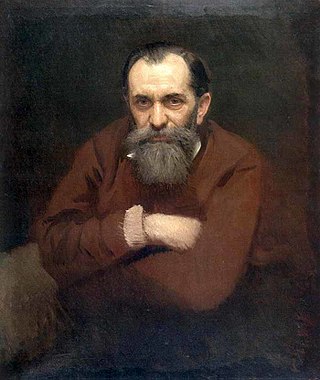
Vasily Grigorevich Perov was a Russian painter, a key figure of the Russian Realist movement and one of the founding members of Peredvizhniki.
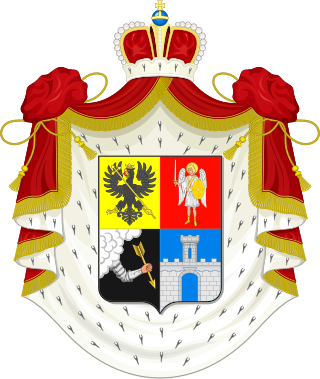
The House of Dolgorukov is a princely Russian family of Rurikid stock. They are a cadet branch of the Obolenskiy family and as such claiming patrilineal descent from Mikhail of Chernigov.

Orest Adamovich Kiprensky was a leading Russian portraitist in the Age of Romanticism. His most familiar work is probably his portrait of Alexander Pushkin (1827), which prompted the poet to remark that "the mirror flatters me".
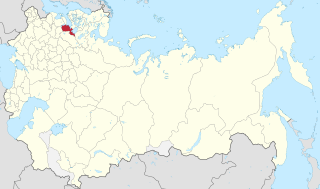
The Saint Petersburg Governorate was a governorate of the Russian Empire, with its administrative centre in Saint Petersburg. The governorate was composed of 44,613 square kilometres (17,225 sq mi) of area and 2,112,033 inhabitants. The Saint Petersburg Governorate was bordered by the Estonian and Livonian Governorates to the west, the Pskov Governorate to the south, the Novgorod Governorate to the east, the Olonets Governorate to the northeast, and the Vyborg Governorate of the Grand Duchy of Finland to the north. The governorate covered most of the areas of modern Leningrad Oblast and Ida-Viru, Jõgeva, Tartu, Põlva, and Võru counties of Estonia.

Count Pyotr Alexandrovich Rumyantsev-Zadunaisky was one of the foremost Russian generals of the 18th century, and one of the great military commanders in universal history between 1618 and 1905. Rumyantsev used mobile divisional squares for the first time in history as opposed to linear battle orders and initiated the formation of light (jaeger) battalions in the Russian Army, which operated in a scattered order.

Count Pavel Sergeevich Potemkin, sometimes spelled Potyomkin or Potiomkin, (1743-1796) was a Russian statesman, soldier, and writer.
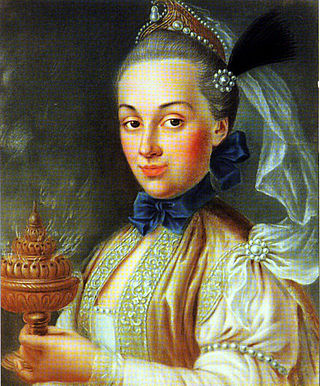
George, Prince of Georgia was a Georgian royal prince and a general in the Russian service.
Ivane Abkhazi or Ivan Nikolayevich Abkhazov was a nobleman from Georgia, who served in the Imperial Russian military and rose to the rank of major-general during the Caucasus War.

Prince Vasily Mikhailovich Dolgorukov-Krymsky was a general of the Russian Empire and Governor-General of Moscow from 1780 to 1782. Already a seasoned veteran of several wars, he was a senior military commander of the Russo-Turkish War of 1768–1774, where his forces occupied the Crimean Khanate, from which he derived his honorary title of "Krymsky".

Events from the year 1787 in Russia
Events from the year 1786 in Russia
Events from the year 1791 in Russia
Events from the year 1801 in Russia

The House of Tatischev is a Russian noble family traditionally believed to be descended from the Princes of Solomerech of the Rostislavichi of Smolensk. This version of the Tatischev family's genealogy had made it to the Velvet Book. A cadet branch of the family bears the title of counts. The Tatischevs are listed in the Parts 5 and 6 of the genealogical books of Moscow, Tver, Tula, Kostroma, Penza and Saint-Petersburg governorates. From the four lineages of the family, the cadet one was granted the title of counts in 1801.
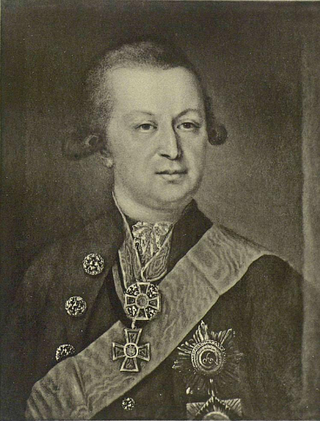
Prince Gavriil Petrovich Gagarin was a Russian writer, senator and minister of the Gagarin family. Active Privy Councillor (1800), under Paul I – member of the Imperial Council, under Alexander I – Minister of Commerce. One of the largest figures of the Masonic movement in Russia.

The House of Kropotkin is an ancient Russian noble family of Rurik stock descending from Prince Dmitry Vasilyevich nicknamed Kropotka, a nephew of the last Grand Duke of Smolensk, Yuri Svyatoslavich. Princes Kropotkin are listed in the 5th part of the Kazan, Kaluga, Mogilyov, Moscow, Ryazan, Saint-Petersburg and Tula genealogical books and 2nd part of the Moscow genealogical book.
Prince Vasily Vasilievich Golitsyn was a Russian commander, nobleman and governor. Golitsyn was a prominent figure during the Time of Troubles between 1587 and 1613.















